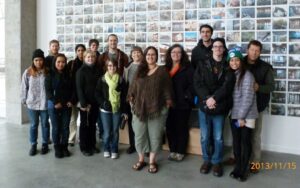
On Friday November 15th, Sustainability at Bellevue College visited the Bullitt Center, the world’s greenest commercial building. Arriving around 11:00 a.m. we were greeted by the Bullitt Center’s Program Coordinator, Deborah Sigler, who works for both Bullitt center and the University of Washington Integrated Design Lab. Beginning with an introduction of the buildings history and philosophy Deborah presented us with an informative video about the World’s Greenest Office Building.
The Living Building Challenge
The Bullitt Center is a part of the Living Building Challenge that looks at seven categories for green design. The seven categories are:
- Site: The location will support a pedestrian, bicycle- and transit-friendly lifestyle.
- Water: Rainwater will be collected on the roof, stored in an underground cistern and used throughout the building.
- Energy: A solar array will generate as much electricity as the building uses.
- Health: The building will promote health for its occupants, with inviting stairways, operable windows and features to promote walking and resource sharing.
- Materials: The building will not contain any “Red List” hazardous materials, including PVC, cadmium, lead, mercury and hormone-mimicking substances, all of which are commonly found in building components.
- Equity: Unlike many office buildings, large operable windows will offer fresh air and daylight to all the people who work in the Bullitt Center. The goals of Seattle’s Community High Road Agreement will guide selection of the construction team.
- Beauty: Stunning architecture, an innovative photovoltaic array, a green roof and other native plantings, large structural timbers and a revitalized neighboring pocket park will help beautify the surrounding streetscape.
The architecture is designed to mimic nature’s exquisiteness through form and function and works with the built environment rather than against it. From the solar panel roof, to the rain water basin, as well as the composting toilets (that do not use any water – just Earth’s gravitational pull) the whole building takes advantage of sunlight, rain, wind and even gravity to produce this environmentally focused building!
As Bellevue College thinks about constructing new buildings we hope that by visiting the Bullitt Center it will give birth to new inspiration and enthusiasm for buildings that are not just about form and function, but also mimic nature’s beauty and genius. While the Bullitt Center is the first of its kind, Denis Hayes (the President of the Bullitt Foundation) believes that it will not be the last and hopes to inspire buildings that meet and go beyond the Living Building Challenge. The Bullitt Center is evidence that buildings can co-exist in harmony with nature, for through its very existence… no one can say that it is impossible to build!
Last Updated January 14, 2014
